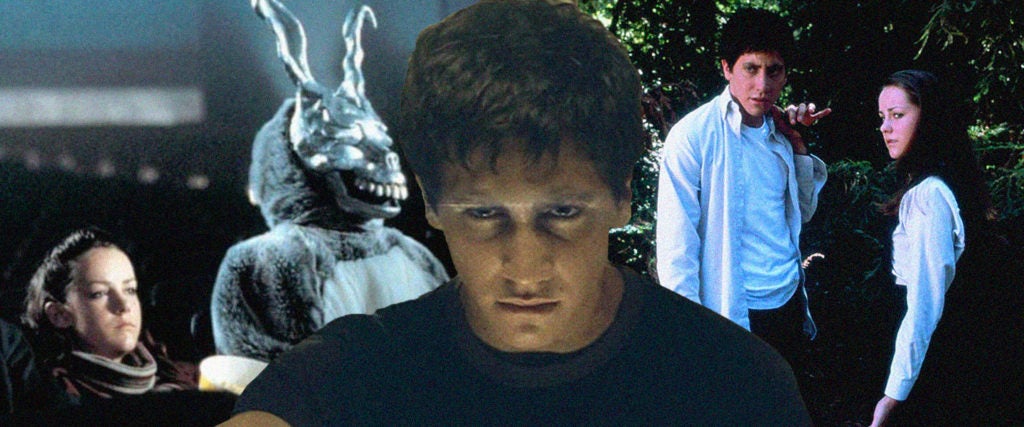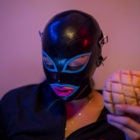With more and more movie streaming services popping up, it can feel impossible to keep track of what’s showing where. So to help, this October I’ll be recommending a different film every day from one such service that embodies the spooky spirit of the season. From classic Halloween movies to indie horror to campy dark comedies, this is 31 Days of a Very Chingy Halloween.
For the 20th anniversary of its theatrical release, I’m looking at Donnie Darko, Richard Kelly’s symbolically dense supernatural teen movie, currently streaming on Amazon and Pluto TV.
Donnie Darko (Jake Gyllenhaal) is an angsty teenage boy in therapy for his emotional issues and sleepwalking habit. On the night of October 2, 1988, he sleepwalks out of his house and arrives at a golf course, seemingly guided by the voice of a ghostly, 6-foot-tall rabbit named Frank who tells him that the world will end in 28 days, 6 hours, 42 minutes and 12 seconds. The next morning, he comes home to find that a jet engine has crashed into his bedroom — it would’ve killed him had he not wandered into the night. Donnie acts even stranger over the weeks following his brush with death, continuing to see visions of Frank, who manipulates him to commit a series of crimes and possibly even gives him the power to travel through time.
Full of bizarre iconography, discussions of metaphysics and a bounty of profanity-laden speeches taking down authority figures, Donnie Darko is the kind of movie that seems to hold the answer to everything when you’re under the age of 18. With all its peculiar dream imagery and parallel timelines, it’s like Mulholland Drive if it were made specifically for maladjusted teenagers. Everything about it relates to that youthful confusion, which makes sense given that it was written by Richard Kelly when he was just 24 and fresh out of film school (it was filmed just a few years later, in 2000).
Living in suburban Virginia at the height of the Reagan era, Donnie is driven by an easily recognizable anger with the hypocrisy around him. In this case, that comes in the form of ineffectual authority figures like religious fundamentalist teachers and a supercilious self-help guru played by Patrick Swayze. Donnie is the quintessential highly intelligent underachiever, inquisitive to a fault but uninterested in fitting into what is expected of him.
His criminal actions throughout the film serve as an attempt to find truth via literal destruction of the status quo. But his frustrations stem from more than just a Holden Caulfield-like hatred for phonies. He’s unsettled by the ways he’s changing, finds despair in his own theological questions and is embarrassed by his budding sexual feelings.
Donnie Darko is a movie obsessed with concepts of fate and destiny, for which suburbia serves as a poignant backdrop — it’s the kind of community where your entire life can feel pre-decided. At certain points, Donnie can see destiny laid out before him in “liquid spears” that sprout from people’s chests down the paths they are going to take. Donnie questions whether or not he can break away from the path set before him. The sense of teenage uncertainty is palpable, in part because the film expertly captures adolescent disconnect from reality and partially just because the story is dense as hell.
When Donnie Darko premiered at Sundance in 2001, many considered it to be an impressively ambitious and original filmmaking debut, but no one wanted to buy the picture or take a chance on it for those very same reasons. When it was finally picked up for a theatrical release, it came out just a month after 9/11 to mixed reviews, and it bombed at the box office. It wasn’t until after it received much warmer reviews in the U.K. that it began to gain a cult following in the U.S.
Part of what made Donnie Darko so iconic was Kelly’s impeccable sense for mood. The film opens on Donnie as he wakes up in the middle of nowhere as “The Killing Moon” by Echo & The Bunnymen (or “Never Tear Us Apart” by INXS if you’re watching the director’s cut) plays on his bike ride home. A twirling tracking shot takes you through Donnie’s high school, getting you high on teenage hormones and establishing all the characters through brief glances to the tune of Tears for Fears’ “Head Over Heels.” The original score by Michael Andrews is stark and eerie, scoring climactic late-night bike rides that bely a teenage innocence and of course culminating in his iconic and heart-rending rendition of “Mad World” with singer Gary Jules.
I first saw Donnie Darko when I was 13. It felt like the movie that defined my coming-of-age before any other, having been the first film I watched specifically because a girl I liked recommended it to me. It’s a film that begs the question, “What if you were the messiah, but you were also a really horny, annoying teenager who’s kind of shit at being messianic?” Though I feel little emotional resonance with Donnie’s state of mind now, the content of the film is remarkable to me beyond nostalgia for its plentiful needledrops, lines like “go suck a fuck” or the infamous Smurf speech. Now, the story feels allegorical to that of Kelly as a filmmaker — a young man following his vision even if it seems ridiculous and no one wants to take a chance on it.
It’s not the most mature movie, but it doesn’t have to be mature to be a classic ode to how scary coming-of-age can feel.
To see a list of each of the previous entries, check out the A Very Chingy Halloween list on Letterboxd.

